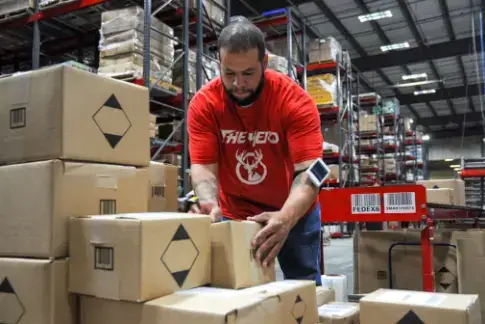The economy is constantly in flux — but that doesn’t mean your eCommerce store can’t weather all the storms and keep growing. Fluctuations in the economy mean there are exploitation opportunities in many new growth areas.
On the flip side, it’s forecast that there’s a 96% risk of a recession next year — meaning that the economy is finely balanced. While customers are currently in a buying mood, a recession can rock the eCommerce world.
This means that ensuring the continued growth of your eCommerce business requires you to stay on top of trends, pay attention to details, and execute the right changes.
In this article, we’ll share the best ways you can ensure your online store thrives in 2023.
Top 5 Ways to Ensure Your Online Store Thrives
- Keep your costs down
- Target loyal customers
- Diversify your product offerings
- Increase customer order fulfillment satisfaction
- Leverage user-generated content (UGC)
1. Keep costs down

Online stores will occasionally face challenges related to the economy, new and emerging competitors, and eternal battles with market leaders like Amazon. It makes sense to ramp up the expenses to keep up with the competition.
However, to give your online store a chance to grow, it’s better to cut costs where you can — without selling yourself or your customers short. Here are some examples:
-
Minimize returns
Regular returns can be damaging because you’re still paying for the shipping and losing out on sales.
Make sure customers know what they’re getting. Write accurate product descriptions and add clear photos. Give customers longer to make a return, as this can make them think twice before making a hasty recovery.
-
Get a better price from suppliers
It’s worth trying if you can clinch a discount with your suppliers. Whether this is possible depends on your current relationship with them. But if you’ve got a silver tongue, use it to cut a good deal.
For instance, you could make bulk orders or larger purchases or agree on longer payment terms in exchange for a lower price. You can also shop around—are there suppliers offering better prices?
-
Tighten your marketing budget
Look at the ROI of your current campaigns and find which avenues are working for you and which are definitely not.
For example, while it’s well worth implementing a social media campaign, you might find that some social channels are redundant. It’s the same with geo-targeting — should you target specific countries and ignore others? Scrap the low ROI routes and pump your money into the high ROI marketing channels.
2. Target loyal customers
If you can increase your customer lifetime value, you will always have customers despite a volatile economy.
Even if customers experience a dip in their purchasing power, that doesn’t mean they’ll stop shopping online altogether — it just means they’re more likely to stick to brands they already know and trust.
What’s more, statistics show that, in the long term, it’s cheaper to retain loyal customers than constantly seek new ones. One of the most obvious ways to retain existing customers is to create a loyalty program that rewards them for their repeat purchases.
You can add several tiers to your program or include a points program that allows them to rack up points anytime they buy a product from you. Over time, you can redeem these points for cash or discounts.
You can reward your customers anytime they refer a friend or family member to your store. You should build lasting relationships with them via regular newsletters that keep them in the loop about your store.
Attach customer reviews and testimonials to your emails as social proof and add them to your website.
Just like LotusBelle does:

If you’re unsure what would make a customer loyal to you, create surveys and polls to find out what they love (and maybe don’t love) about your store.
3. Diversify your products
Product diversification is a solid eCommerce growth tactic because it can help to plug the gaps and sustain cash flow when certain products aren’t selling. And it does happen: one day — unexpectedly — the demand for your biggest-selling product drops. Then what?
The more products you sell, the more you safeguard yourself against an economic disruption that could cause sales to plummet when a particular product suddenly stops being popular or needed.
Take a look at your biggest competitors and see what it is that they’re selling and you’re not.
What are they achieving sales with? You can use a tool like iSpionage to find your closest PPC rivals, which can help point you toward your competitors and what they’re selling.
Dropshipping is worth exploring if you're looking to diversify your product offerings.
By partnering directly with a supplier and selling their products in your store, you can offer a wide range of items without worrying about storage or inventory management.
When a customer makes a purchase, you simply order the product from your supplier at a wholesale price. They handle the shipping directly to the customer. This allows you to sell various products without the upfront costs and risks associated with traditional inventory management.
Drop shipping can be a cost-effective way to expand your product line and increase revenue.
Whatever you do, test any products before you launch them fully. You could run a Google AdWords campaign to validate your offerings and take pre-orders. This will ensure that when you diversify your products, you still sell items that your customers want.
If, on the other hand, you sell just one product, you can still focus on iteration and improving your offering. You can also communicate your message to customers so that they believe in it as much as you do.
4. Increase customer order fulfillment satisfaction

Timely order delivery is critical to customer satisfaction, and failing to meet this expectation can result in losing loyalty and business.
Therefore, it's essential to prioritize efficient and reliable shipping processes to retain your customers and maintain a positive reputation.
What’s more, statistics have shown that while almost 50% of customers will gladly wait two days for their delivery, the number drops by nearly half for customers who must wait 3–4 days.
This means that faster delivery leads to more satisfied customers, which in turn equals more growth for your store.
Improving your eCommerce fulfillment is an easy way to boost customer delivery times. It streamlines your supply chain operations with better inventory management, so you can pack, ship, and deliver orders on time.
eCommerce order fulfillment covers everything from where you source your products to where you store them, process them, and get them to your customers.
A 3PL partner will take care of your warehouse operations for you. They also specialize in optimizing freight shipping, ensuring your products reach customers faster and at a lower cost.
When orders arrive, they will utilize ELD-mandated transport and tracking technology to ensure your orders arrive at their final destination on time, thereby improving customer satisfaction.
Other options include a 4PL and 5PL, which cover even more than a 3PL and manage the 3PL for you so that you can focus on your business’s core aspects.
Partnering with ethical suppliers who use sustainable packaging is also a brilliant idea. It’ll go a long way toward enhancing your brand’s reputation and boosting customer loyalty, especially in a world where over 60% of customers say they are concerned about the planet's future.
If you go down this route and adopt other eco-friendly practices, communicate your sustainability efforts to your customers.
Alternatively, you could fulfill your orders, in which case you’d need to minimize your shipping zones, slash the time in transit, ask your app developer to create product tracking software, and find other cost-cutting measures, such as investing in inventory management software to avoid overstock and understock.
5. Leverage User-Generated Content (UGC)
User-generated content is a popular type of social proof —, and social proof is a huge driver of sales in eCommerce. Research shows that 97% of people read customer reviews before purchasing.
So, while you should find ways to increase customer reviews in your store, you should also explore user-generated content.
UGC is content that your existing customers create. It could be a video of them using your product, Instagram Stories, blog posts — and more. The idea is that your customers flaunt and promote your brand for you.
There’s not much you need to do except encourage more UGC! Here are some tips:
-
Offer an incentive
While some customers who love your brand will create UGC without an incentive, others might need one. Think of a cool, relevant incentive (such as gift cards) to encourage people to create content for you.
-
Use hashtags
You could run a UGC campaign on Instagram and use a unique hashtag that customers must use to create and post their content. This would make their UGC easy for others to find.
For example, online clothing retailer Asos used the hashtag #AsSeenOnMe, where customers could take photos of themselves wearing outfits they’d bought from Asos.
The hashtag allowed Asos and other customers to find them, while the pics showed everyone what Asos’s clothes look like on real people.

-
Share!
Once you have your content, make the most of it. Email it to your customers, post it on your social media channels, and let people know what they’ll gain if they create UGC, too.
-
Make sure to moderate all content
Not all UGC will be suitable—some will align with your brand values, and others will not. Ensure a team member who knows your values reviews all UGC before posting anything in your name.
Conclusion
Economies fluctuate, but online stores can take advantage of opportunities no matter what is currently happening. Online stores have bucked the trends before and thrived during economic downturns.
Those who pay attention to the right things, such as trends in customer behavior and understanding what your customers want at all times, will continue to thrive.
Regardless of what happens outside of your control, the important thing is to build long-term relationships with your customers through on-time deliveries, social proof, and customer loyalty tactics.
The more customer-centric your online store is, the more you can grow in today’s economy.
Author Bio
Alex Selwitz is the Director of SEO for Red Stag Fulfillment, an eCommerce fulfillment warehouse born out of eCommerce. He has years of experience in eCommerce and digital marketing. In his free time, Alex enjoys playing guitar and learning about new trends in the digital world.



